Computer and Network Security
Table of Contents
Lecture 3: TCP
TCP seq/ack numbers:
- sequence: specify position of segment data in communication stream (i.e. if number is 13423, means payload contains data from byte 13423 to byte
) - acknowledgment: specify position of next byte expected from comms partner
TCP windows:
- used for flow control
- segment only accepted if sequence number is inside window that starts with current ack number (ack number < seq number < ack number + window size)
- window size changes dynamically to adjust amount of info sent by sender
TCP flags: used to manage establishment and shutdown of connection
- SYN: request for sync of syn/ack numbers (to set up connection)
- ACK: states ack number is valid
- FIN: request to shutdown one stream
- RST: request to reset virtual circuit
Connection setup (3-way handshake)
- Server listening on port receives connection request from client
- segment is marked with SYN flag
- segment contains random initial seq number s𝑐
- server answers with segment marked with SYN and ACK flags, containing
- initial random seq number s𝑠
- s𝑐+1 as acknowledgment number
- client sends segment with
- ACK flag set
- sequence number s𝑐+1 and acknowledgment num s𝑠+1
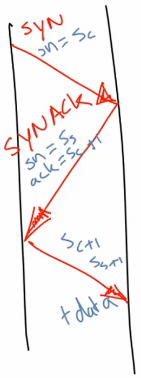
What’s the initial sequence number?
- TCP standard (RFC 793) specifies that seq number increments every 4 μs
- BSD used number incremented b 64k every half second and every time a connection is established
Connection shutdown
FIN:
- One partner sends segment with FIN flag
- Other partner answers with ACK segment
- No more data will be sent from partner that sent FIN, only acks received data.
- Connection closed when acking partner shuts down stream.
RST: just send a packet with the RST flag.
Spoofing
attack to impersonate another host when establishing TCP connection
Node A trusts node B (e.g. whitelist login from a specific IP). So, node C wants to impersonate node B wrt A when opening TCP connection.
- C kills B (denial of service, crashing…) so that B doesn’t send RST segments
- C sends TCP SYN to A in spoofed IP packet, using B’s address as source IP and s𝑐 as seq number.
- A replies with SYN/ACK segment to B with s𝑠 as seq number; B ignores the segment because it’s too gone
- C doesn’t receive the segment, but has to send ACK with s𝑠+1 as acknowledgment number
- C eavesdrops SYN/ACK segment
- or C guesses the right number
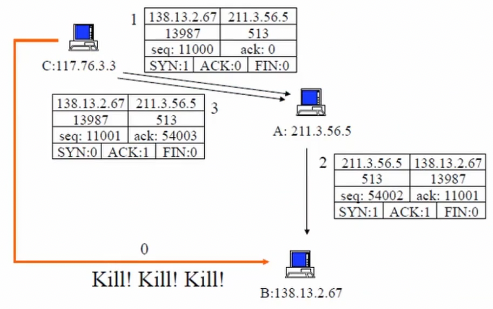
Hijacking
Joncheray-style
Takes control of existing TCP connection. Attacker uses spoofed TCP segments to
- insert data in streams
- reset existing connection (denial of service)
The correct seq/ack numbers must be used:
- can eavesdrop client-server traffic
- can guess right seq/ack numbers
- Assume attacker can sniff traffic (see all packets between C and S)
- Attacker waits until connection is quiet (all transmitted data have been acknowledged by both endpoints)
- Attacker sends injected data with correct ack𝑐, seq𝑐
- ACK storm ensues:
- receiver of injected data sends ack to apparent sender
- apparent sender replies with ack with “expected” seq number
- receiver considers it out-of-sync, sends ack with “expected” seq number
- ACK storm continues until a message is lost. Any subsequent attempt to communicate will lead to ACK storm.
- we can use ARP poisoning to send ACKS to non-existing hardware address
- send RST packets to both parties
- ACK storms can be blocked by attacker using ACK packets with right numbers
- If packets are desynchronised so much that they’re out-of-window, they are automatically dropped by the parties. But attacker can relay and modify the data.
You can also get desynchronisation by:
- waiting for SYN/ACK from S to C
- then sending RST to S and open new connection immediately with same port etc. (but different client seq number)
- S sends SYN/ACK with A acknowledges, and S now in established state
New attacks - off-path
Challenge ACK rate limit
TCP side channel vulnerability in Linux 3.6+, because RFC 5961 changed the SYN receiving scheme and Linux implemented it to the letter. A challenge ACK packet is sent in an established connection in these cases:
- SYN packet with correct <srcIP, dstIP, srcPort, dstPort> (any seq num)
- RST packet with correct <srcIP, dstIP, srcPort, dstPort> (in-window seq num)
- Data packet with correct <srcIP, dstIP, srcPort, dstPort> (in-window seq num, old ack num that’s in challenge window)
Vulnerability: recommended to rate limit the challenge ACK packets, Linux did this
sysctl_tcp_challenge_ack_limit: global limit (default 100) of all challenge ACK per sec, across all connections- fixed in Linux 4.7. can fix by adding random noise to the channel (rate limit) or eliminate it
Given any two hosts on the internet, a blind attacker can infer:
- existence of communication
- sequence number
- ACK number
Can be used towards attacks of
- TCP connection termination
- Malicious data injection
Threat model:
- arbitrary pair client & server
- blind off-path attacker (no eavesdropping)
- assumption: attacker can send spoofed packets with victim’s IP address
Attack:
- Send spoofed packets with guessed values (like source port) to trigger challenge ACKs.
- If the guess is right, the legit client gets a challenge ACK, and we get one less challenge ACK.
- If it’s wrong, we get all challenge ACKS back.
- Repeat step 1 for either:
- SEQ number: spoofed RST packet and 100 legit RST packets
- ACK number: spoofed Data packet and 100 legit RST packets
Time cost is additive, can be done in one minute. Optimise using binary search for ports: send spoofed packet for all ports in first half range, narrow down search space by half and go to next round.
ACK throttling time synchronisation is important:
- challenge ACK count resets each second
- so all spoofed and legit packets must be in same 1-second interval at server
Synchronisation method:
- split 1 second into 200 time slots
- send 200 RST packets in one second, one in each slot
- receive max 200 challenge acks back (100 in first second, 100 in second second)
- adjust until you get exactly 100 challenge acks back
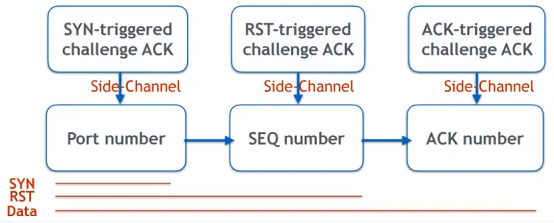
IP identifier (IPID)
Still uses challenge acks. Instead of shared limit on challenge acks, use IPID as shared counter.
Linux > 4.18, two ways to select IPID counter: per socket, or hash-based (shared)
Attack:
- detect victim clients:
- force server’s IPID assignment from per-socket to hash-based
- DF flag in packet can be cleared with ICMP packet
- pretend to be a router, send forged ICMP “fragmentation needed” message to victim server
- embed ICMP echo reply data in the forged message
- server will clear DF flag of next packets sent to client whose IP address is in embedded echo reply
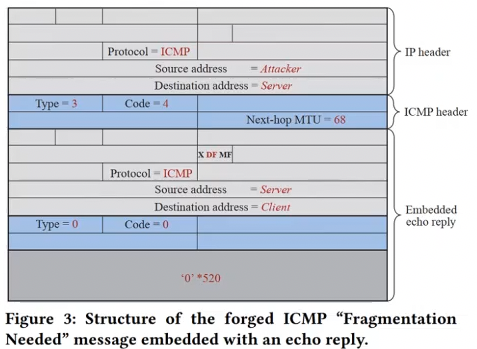
- through hash collisions, detect victims with same IPID counter as attacker.
- one of 2048 hash counter is selected based on source IP, dest IP, protocol number, and random value
- if hash(TCP packets sent to victim) == hash(packets sent to attacker), server uses same IPID counter
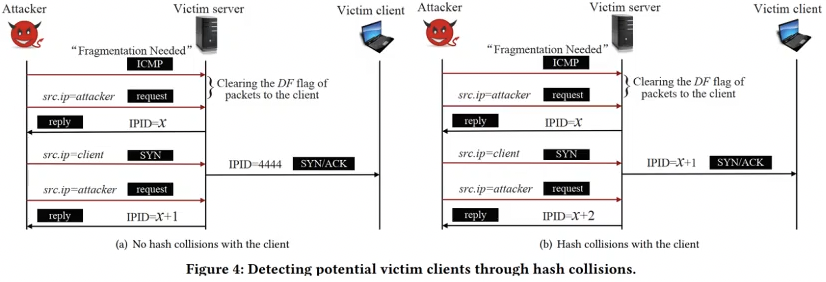
- hash-based IPID counter doesn’t increase linearly, the increment is a random value based on system ticks, so that must be restricted
- force server’s IPID assignment from per-socket to hash-based
- detect TCP connections and source port:
- continuously send ICMP echo requests, observe IPID values of server’s reply
- then send SYN/ACK with guessed source IP/port.
- if correct: challenge ack and jump in counter
- if incorrect: RST packet to real client with IPID 0, so no jump in counter
- infer seq and ack numbers:
- Infer acceptable seq numbers (in server’s receive window)
- continuously send ICMP request packets to server, observe IPID values of replies
- send spoofed RST packet with guessed seq number
- if correct: challenge ACK, so increase in counter (IPID)
- if incorrect: not in server window, so discarded and no counter increase
- Locate challenge ack window
- when receiving data packet, 3 options:
- ACK number in challenge ACK window: challenge ACK
- ACK number in acceptable ACK range
- invalid ACK number
- continuously send ICMP request packets to server, observe IPID values of replies
- send spoofed ACK packet with guessed ACK number to server
- if ACK in challenge ACK window, challenge ACK packet sent & jump in counter
- otherwise, no jump
- when receiving data packet, 3 options:
- Detect lower boundary of server’s receive window
- forge multiple ACKs with constant ACK number that’s in challenge ACK window, and seq number set to <acceptable_sequence_number-i>
- at start, server will send challenge ACKS one per 500ms
- once <acceptable_sequence_number-i> reaches lower boundary, server starts sending duplicate ACKs without rate limit
- Detect acceptable ack numbers
- send multiple probing ACKs and observe IPID counter
- forged probing ACK packets have seq num seq_acceptable, ack num is set to <ack_challenge-i>
- challenge ACKS triggered until <ack_challenge-i> reaches lower bound of challenge ACK window
- acceptable ack range inferred by adding 2*2³⁰ to detected boundary
- Infer acceptable seq numbers (in server’s receive window)